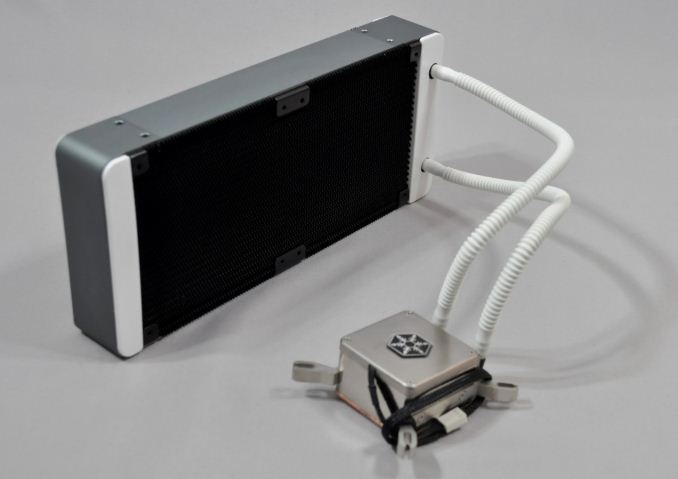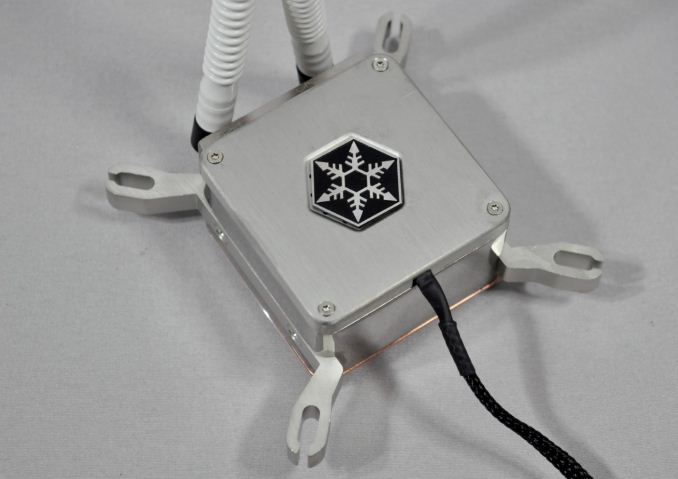Closed Loop AIO Liquid Coolers: 14-way Mega Roundup Review
by E. Fylladitakis on February 12, 2014 7:00 AM ESTSilverstone
Silverstone is another well-known name amongst advanced users and enthusiasts. The company earned their reputation from their first PSUs and original case designs and soon diversified towards cooling related products. They currently offer just two AIO liquid cooling solutions, the Tundra series. The company shipped both of them to us for this review.
Silverstone Tundra TD02
Silverstone ships the Tundra TD02 inside a large cardboard box with a black/blue theme. The box has plenty of pictures and information about the cooler printed on all of its sides. The company also supplies a fairly standard bundle with the Tundra TD02, which consists of a manual with installation instructions, mounting hardware and a syringe with thermal compound. There also is a 3-pin Y-splitter fan cable included, which can be used to power two fans off a single header. Silverstone supplies two 120mm fans with the TD02. The fans have back frames and curved, notched white blades that supposedly reduce aerodynamic noise, as well as fluid-state bearings for prolonged life. Their speed range is rather narrow, ranging from 1500 to 2500 RPM.
Visually, the Silverstone Tundra TD02 certainly stands out a lot. Although it is somewhat different, the Tundra TD02 could be coming from the same OEM that makes the Enermax Liqtech 120X as well; however, Silverstone did not want to reveal their source. The very large and deep radiator with the grey aluminum frame stands out, the size of which overwhelms any Asetek/CoolIT design. Size is not always a good thing though, as the 45mm thick design could bring serious compatibility issues, especially if the case has been designed with 27-29mm radiators in mind.
The design of the radiator is quite different from that of most other kits. Like the radiator of the Liqtech 120X, instead of wavy aluminum fins between the liquid pass-through channels, this design forms single, "seamless" fins from one side to the other, which are soldered onto the channels. The design of the fins and the overall size of the radiator though is different.
The block-pump assembly of the Tundra TD02 stands out over that of most other kits as well. It is entirely metallic, made of nickel-plated aluminum with a copper base. A badge with Silverstone's logo lies in the middle of the aluminum cap, which also has very subtle blue LEDs surrounding it. There is something unique about this block however; unlike any other assembly, including that of the Liqtech 120X, the copper base of the block is not attached to the assembly with screws, leaving the bottom of the block entirely plain. It has also been machined down to a perfect, smooth finish. The only thing that we could complain about is the use of narrow, stiff, white corrugated tubing, which is beneath the quality of such a product.
Silverstone Tundra TD03
Confusing as this may be, the Tundra TD03 actually is a smaller version of the TD02. It comes in a similarly designed cardboard box with a black/blue color theme, only it's significantly smaller. Despite the change in size however, the cooler remains very well protected within cardboard packaging and inside nylon bags. It also shares exactly the same bundle with the TD02, including the manual with the installation instructions. The two 120mm fans supplies are the same as those of the TD02, with a black frame and curved, notched white blades.
Both visually and practically, the Tundra TD03 is just a shorter version of the TD02. The radiator also shares the same design, and is just as wide and thick as the radiator of the TD02, yet nearly half as long, which means that it essentially has half the heat dissipation surface. Nevertheless, Silverstone still supplies two 120mm fans, to be used in a push-pull configuration. It is interesting to note that this radiator design appears a lot more solid, without any imperfections or bent fins, which appear to be very common on radiators with wavy aluminum fins.
As expected, the fully metallic block-pump assembly of the Tundra TD03 is identical to that of the TD02. The top and frame of the assembly are made out of nickel-plated aluminum, with the base of the block made out of solid copper. Even the mounting braces are made of solid aluminum, with those meant for Intel CPUs preinstalled on the block from the factory. Once again, the copper base is not attached to the aluminum frame with screws, at least not screws visible from the bottom of the assembly, leaving the base of the cooler perfectly clean and smooth.
























139 Comments
View All Comments
jmke - Wednesday, February 12, 2014 - link
as with everything, the noise scale and extreme focus of SPCR does give a slightly twisted view.none of these AIO would qualify as silent, anything above 30dBA would be loud for him; his kitchen is <30dBA... ;-)
EnzoFX - Wednesday, February 12, 2014 - link
>30DB is loud lol. At least audible to anyone I would say, so can't we at least say it's not silent? Furthermore he'd provide at least a vast array of reference points, where Anandtech is severely lacking when it comes to cooling/cases/etc.E.Fyll - Wednesday, February 12, 2014 - link
Definitely not loud and not even audible to most. 30 dB(A) is the lowermost threshold that the vast majority of sound level meters can take a reading from. I have provided a thorough explanation about this down below in the comments. I personally consider any test that I have seen stating that they got a valid reading below 30 dB(A) with sub - $30k equipment to be rubbish.Jon-R - Wednesday, February 12, 2014 - link
So you're saying that the tests over at SilentPCReview are rubbish? What sound measurement equipment did you use? I couldn't find a mention of it.JlHADJOE - Thursday, February 13, 2014 - link
30 dB is very quiet far as background noise goes.Whisper Quiet Library at 6' 30dB
Sauce: http://www.gcaudio.com/resources/howtos/loudness.h...
JlHADJOE - Friday, February 14, 2014 - link
It's not so much that their tests are rubbish, just unrealistic.SilentPC tests in an anechoic chamber, so the noise floor when they test is near zero. Compared to that, an increase to 30dBA is very loud. But in a real-world environment, 30dBA is whisper quiet.
I do agree though that use of the anechoic chamber keeps their tests consistent and repeatable. Just not necessarily representative of what a case will actually sound like in a real room.
YazX_ - Wednesday, February 12, 2014 - link
Thx for this thorough review, i have corsair H100i, its awesome AIO cooler, but the fans are piece of shit and very noisy, i replaced them with Bitfenix LED ones, although they operate at 1800 RPM, but i never had to see them operate on that speed, my CPU is OCed to 4.5Ghz and max temp is 65, so they work 50% most of the time and pretty silent.AshyPistachios - Wednesday, February 12, 2014 - link
This ended up comparing fans more than it did rads/pumps. I would like to see a test scenario where identical fans are used on each rad. The current testing methodology does test the complete package, but people seeking silent setups tend to swap all of the fans anywayMrSpadge - Wednesday, February 12, 2014 - link
Agreed - comparing performance doesn't mean much with such different fan noise levels. You could use some high pressure fans for all systems, for example.And I couldn't care less if a stock fan runs at 7 V or what ever. What I do care about is the noise. In practice I set my rigs up for the best cooling I can get at subjectively low noise level (they're running 24/7 under load). So pick any reasonably quiet noise level, set the fans to whatever speed is required to get there and then compare performance (note: this is even more meaningful if you use similar fans). With PWM you're not limited to 12V and 7V, it's not 2005 any more.
E.Fyll - Wednesday, February 12, 2014 - link
7 Volts is about the same voltage level as most modern motherboard apply in their "quiet" mode. High enough to start nearly all fans ever made, low enough to keep things quiet. Unfortunately, I cannot perform testing the way you propose. As you mentioned yourself, it would have to be a "subjectively low" noise level. The very word "subjectively" puts me off. Even if I do set such a noise limit, which would be terribly wrong as it would just be based on my subjective opinion, not all coolers would be able to operate as such a noise level at all.It is even less meaningful to use the same fans; when you are buying a kit, you are buying the kit with its fans. Purchasing additional fans not only raises its cost but, depending on the characteristic behavior of the fan, the fan itself can affect performance and favor some kits over others. The actual performance of a fan is not based on its RPM or CFM ratings, it is a very complicated matter. That would render any comparisons between different kits virtually useless. Furthermore, the choice of fans would be based on my subjective opinion as well, nobody warranties that the end user will be purchasing the same fans out of the hundreds of possible choices. Someone would want me to use a quieter fan, others might want something more powerful, others something cheaper, others something fancier and so on. And of course, most would just want to buy a kit and be done with it. The only objective comparison is to compare the performance of a kit with its stock fans, as it comes supplied from the factory. Everything else is based on assumptions and subjective opinions that, including mine, have no place in an objective review.